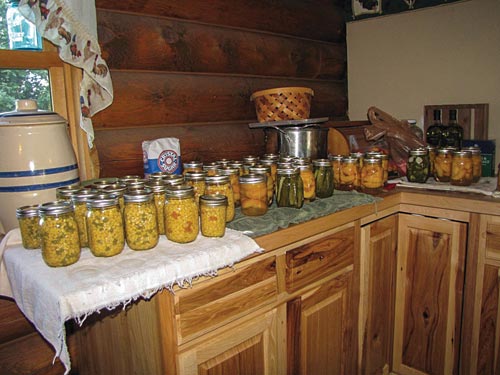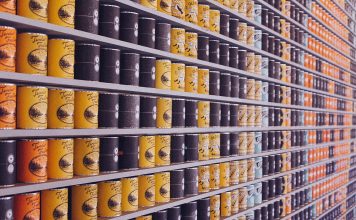 |
|
| Issue #142 • July/August, 2013 |
Canning has been an important part of my life since I was a young girl helping my mother and grandmother can in our Detroit basement. I loved the smell of fresh peaches simmering in syrup and the pungent spices used for making pickles. I loved going out in the garden and picking fresh fruit, cucumbers, and tomatoes. I also loved our family weekend outings in the country, picking up boxes and baskets of foods to can from roadside markets and farmers’ trucks.
In growing up with relatives who experienced the Depression, I soon realized what a wonderful thing it was to have a pantry chock-full of all sorts of foods to “see us by.” Once properly canned and stored in the pantry, any food not eaten during the winter will remain good for years, without losing any of its gourmet taste or nutrition.
Ever since then, I’ve made home canning an important part of my quest for a self-reliant lifestyle. And, boy-oh-boy, have I canned a wide variety of foods! From pickles, jams, jellies, and preserves to venison, pork, beef, chicken, meals-in-a-jar, stews, soups, and nutmeats I’ve canned them all.
I love teaching others about canning. For more information, check out my book, Growing and Canning Your Own Food, my “Ask Jackie” column in BHM, and my blog. I even host seminars here at our homestead. Truthfully, I think everyone who is able should learn how to can. It is an easy, enjoyable, and frugal thing to do.
Throughout the years, I’ve found that there are certain common mistakes that folks (me included) have made. Over and over, I’ve heard “I did this and this, and then my food turned out bad.” I really hate for this to happen because some people just chuck out the whole idea of canning right then and there. So, here are a few mistakes that home canners make and some advice on how to fix these mistakes.
The pressure canner blew up!
There’s always a story floating around that someone’s mother, aunt, or neighbor had a pressure canner that blew up in the kitchen, blowing food and glass everywhere. All I can say is, “Yeah, right…” I hear this all the time. It’s the most frequently-given reason why folks don’t want to try pressure canning.
Let me say here and now that it is nearly impossible for a modern pressure canner to blow up. Modern pressure canners (those built within the last 40 years or so) are equipped with at least one fool-proof safety device a petcock. The petcock releases steam and pressure when it gets over 15 pounds and has a hard rubber plug that pops out if the pressure gets too high. In addition, many canners, such as the All American, come with both a dial and weight. If the pressure gets too high, the weight jiggles and releases steam and pressure. No blowing up.
You do need to monitor your pressure canner while it is building pressure and during processing. Like a deep fryer, you don’t just fill it and go in the other room or outside while it is doing its thing. (A long time ago, my oldest daughters decided to make French fries, so they put the potatoes in the deep fryer and went outside to sunbathe. Needless to say, they ended up having to call the fire department.) You need to monitor your canner’s pressure stay in the same room! If you want to ready another batch of food to can, that’s perfectly fine. But check often to make sure the pressure isn’t climbing past the pressure you are processing your food with.
As an added safety precaution, be sure to always check your petcock and steam vents before you can. Run a needle through them to make sure a bit of food hasn’t blown out of a jar and gotten wedged in the vent. In the past, this is usually what blew up the old canners without safety features. The plugged vent let the steam pressure build up until the lid blew off. Again, with modern canners, this is nearly impossible.

Always use a rack to prevent the jars from coming in contact with excessive heat from the burner. If you don’t, the bottom of the jar may break out!
The bottoms broke out of my jars
This commonly happens during water bath canning. The reason is simple: hot jars put into a cool canner or cool jars put into a boiling canner make the bottoms of the jars crack and break during processing. Always make sure your jars are hot and the canner a little below boiling before you put them together. You can hold your jars in another canner full of boiling water or even hold them in a sink full of hot water so they stay reliably hot. Then pack them quickly and put them into a very warm canner. Even when pressure canning, I always take the time to heat my canner a bit so I’m not putting hot jars of food into a cold canner. By doing this simple step, I have no jar bottoms break during processing.
Another cause of broken jars is setting your jars of hot, processed food directly on a kitchen counter or table to cool. Setting them near an open window with a cool breeze blowing on them will also cause breakage. So will canning outdoors and putting the hot jars, right out of the canner, on a table in a windy area. Make sure there is no wind or breeze, and always set your hot jars on a clean, dry towel and they will cool safely … in one piece!
Tunking jars together while very hot can result in broken jars. The jars should also have enough space between them to create a good airflow. A good airflow results in a good seal.
Liquid blowing out of jars
Liquid blowing out of jars during canning can happen for a couple of reasons. The first and most common reason is letting the pressure vary during processing. Let’s say you are canning at 12 pounds pressure but it slips up to 15 pounds before you notice it. If you quickly turn off the heat and let it go to 12 pounds, then turn the heat back on a couple of times, this can cause liquid to blow out of the jars. It is better to slowly bring it back to the right pressure.
Opening the canner too soon after processing or bumping the weight a couple times to “hurry” things up will also cause liquid to blow out of the jars. Once the pressure goes back to zero after your batch of jars has processed fully, wait five minutes or so. Then release any steam and remove the lid of the canner. Don’t try to save jars by over-packing food. Filling the jars past the recommended headspace will also cause liquid to blow out.
Although unsightly, the food in jars with a low liquid level is perfectly good to eat. A low liquid level does not affect the shelf life or the taste of the food.
My jars didn’t seal
Having a couple of jars that don’t seal in a big batch of canning is nothing to be concerned about. Reprocessing it is easy. Just reheat the food, check the jar rim for nicks or food particles, use a new, previously-simmered lid, and re-process within 24 hours. Or, you can just refrigerate it and eat it.
However, if more than one or two jars fail to seal, there is a definite reason. And the most common reason is not reading directions. Canning is definitely not rocket science, but you do need to follow tested recipes and the directions for every food, every time you can it. Never rely on memory. Even with all my experience, I always open my canning book and read the directions before I can that particular food. It’s a good habit to get into. And you’ll have fewer failures along the way if you do.
One other thing we thought of that quite a few folks have done wrong, including my oldest son, Bill, is to begin counting the processing time in a water bath canner from the time they put the jars into the canner. This is wrong and can result in failed seals, mold, or fermenting foods. The time should always begin when the canner full of jars comes to a full rolling boil.
Examine every jar before you fill them to check for nicks or cracks in the rim of the jar. Always be sure to wipe the rim of your filled jars with a damp, clean cloth to remove any food bits or grease before putting on your lids. When they are done processing, do not wipe the jars and lids before they are cooled. If you have minerals in your water, your jars may have a whitish film on them after they come out of the canner. This film is nothing to worry about, but some folks take a towel and wipe it off before the jars have cooled. The lids will not seal properly if you do this. Wait until the jars have cooled completely, then you can take off the rings and wash the jars thoroughly under warm, soapy water with no ill effect.
When your batch of jars are through with their processing time, let the gauge return to zero or let the canner cool so there is no remaining steam if using a weight only. But do not leave the lid on the canner overnight and assume that the jars will seal just fine. Sometimes they appear to seal, but in storage, the seal releases and the food spoils. Again, read the directions and follow them. When the book says “let the gauge return to zero or allow the canner to cool naturally then remove the lid and remove the jars,” do just that. It does not say to leave them for several hours in the cooled canner!

Be sure to put your hot, processed jars onto a folded, dry towel away from cool breezes. Setting hot jars onto a wet towel, on a bare countertop, or next to an open window can cause broken jars.
My grandmother water bathed green beans
Years ago, home pressure canners weren’t readily available, so people did process foods such as vegetables and even meats by holding them in a boiling water bath canner for three hours. That usually caused the jars to seal, although the food was terribly overcooked. But, no matter how long you hold jars of food in a water bath canner, the temperature of the food in the jars never reaches above boiling.
Boiling temperatures kill molds and yeast, along with some forms of bacteria. But it does not kill the bacteria that cause botulism (food poisoning) or their toxins. So you could boil your green beans for three hours in a water bath canner and still have toxic food in your pantry, even though the jars had sealed. To kill these bacteria, food in your jars must reach 240 degrees a temperature which is only reached inside a steam pressure canner.
No, botulism is not common in this country, but it does occur. Do you really want to gamble your family’s safety by continuing an unsafe canning practice? Again, always read the directions (from a modern canning book) for each and every food you can. All low-acid foods, including vegetables, meats, poultry, and fish (and recipes including them) must be processed in a pressure canner.
Can I reduce the processing time if I boil foods first?
Any time you can up a batch of food, you have to treat it as if you had just mixed it up fresh. This goes for your own recipes of chili, soup, and stew, as well as when you re-can large #10 cans (institutional size) from the store. It’s always possible for bacteria to float into that food between cooking and canning. So to be safe, you must process that food as though it were made up fresh and follow the processing directions exactly in your canning book. If you don’t, you’ll have incompletely processed food that may go bad during storage or expose your family to the danger of food poisoning.
My sweet corn turned brown during canning
There are a couple of reasons why corn turns an unappetizing brown after processing. The most common is that the corn is one of the newer super-sweet varieties. Plant or buy a variety of corn that is not “extra sweet” or “unbelievably sweet.” One popular variety sold is Kandy Korn, a super-sweet best seller. It is very good, eaten fresh. But it is a poor choice to can. I’ve done it with mixed results; some batches are fine, others turn brown.
Another possibility is that the corn was processed at too high a temperature. This often happens when a person fails to monitor the pressure gauge while the corn is processing. If you should be processing at 10 pounds pressure, don’t assume that 15 will make it “better.”
Make sure that water covers the corn well and that you use the correct headspace recommendations.
If you do end up with unappetizing brown corn, it is fine to eat. Most folks won’t want to eat it as a side dish because of its appearance, so just use it in your recipes.
My jelly didn’t set up
This just happens sometimes, even with the most experienced jam and jelly preservers, me included. Personally, I don’t worry about it and just use the unset spread as syrup over pancakes or ice cream. It’s sweet, fruity, and thick enough not to be runny.
I think the most common reason it doesn’t set is from tweaking the recipe in your canning book. Don’t add extra fruit juice to your recipe, thinking that you can get away with adding a little more sugar. It never works out and you’ll be disappointed with unset spreads.
Whether you use a recipe with pectin or not, don’t hurry the boiling of your spread. If your recipe calls for added pectin, add the full amount. Never double a recipe. It often does not turn out well; either it doesn’t set up or it scorches.
If you’ve done everything right and the preserve still doesn’t jell, you can save it and remake it again to get a firmer product. Before re-canning, just remember, some fruit preserves and jellies take up to two weeks to set up. And some fruits, such as chokecherries, are a bugger to set. Whenever I start to cook down my chokecherries, I use apple juice as a liquid, not water. The apple juice is high in natural pectin and helps the chokecherry jam or jelly to set. I also add powdered pectin.
If you want to remake your jam, jelly, or preserves that have not set up after two weeks, here’s how:
Spreads made with powdered pectin, such as Sure-Jel:
To remake failed jelly or jam, only do 8 pints at one time. For each cup of spread, measure 1½ tsp. powdered pectin, 1 Tbsp. water, and 2 Tbsp. sugar. Set sugar aside in a separate bowl. Combine pectin and water in a large saucepan and bring to a boil, stirring constantly to prevent scorching. Bring the pectin and water to a boil over medium heat, stirring frequently to prevent scorching. Add unset preserves (or jam or jelly) and sugar, stirring constantly to prevent scorching and to mix thoroughly with pectin mixture. Bring to a hard boil for 30 seconds. Quickly ladle into hot jars, leaving¼ inch of headspace. Place a hot, new, previously-simmered lid on jar and screw down the ring firmly tight. Process in a water bath canner for the time shown in the original recipe.
Spreads made with liquid pectin, such as Certo:
To remake failed jelly or jam which has been made with liquid pectin, only do 8 pints at one time. For each cup of unset jelly, measure out 1½ tsp. liquid pectin, 3 Tbsp. sugar, and 1½ tsp. lemon juice. Place failed preserves (or jam or jelly) in a large saucepan and bring to a boil, stirring constantly to prevent scorching. Quickly stir in sugar, lemon juice, and liquid pectin. Return to rolling boil, stirring constantly. Boil hard for one minute, stirring constantly. Remove from heat. Ladle hot jam/jelly into hot jars, leaving¼ inch of headspace. Place a new, hot, previously-simmered lid on the jar and screw down the ring firmly tight. Process in a boiling water bath canner for the time required in the original recipe.
Without added pectin (boiled down jam, jelly, or preserves):
Usually when these don’t set, it means you haven’t read or followed the directions correctly. Read them again and recheck your method. If it still seems right, heat the unset product in a large pot until the temperature in the recipe is reached or the jelling point is reached. Be sure the preserves slide off a clean spoon in a sheet instead of dripping off in drips. Then quickly ladle the spread into hot jars, leaving¼ inch of headspace. Place a hot, new, previously-simmered lid on the jar and screw down the ring firmly tight. Process in a water bath canner for the time required in the original recipe.

Cracks and nicks in the jar rim are a common cause of seal failures. Here, I’m checking each jar rim carefully with my finger. Be careful; sometimes nicks in the glass are sharp!
My jars have come unsealed during storage
This happens once in a while, but it should not happen very often. If more than one jar in a large batch comes unsealed, or this starts happening frequently, you have a problem.
The most common cause is that food bits have been trapped under the lid during processing. Be sure to wipe both the rim of the jar and the threads to remove any clinging food particles before putting the lid on the jar. Another cause of food getting trapped under the lid is varying pressure during canning which often blows liquid and small food particles out of the jar during processing. These particles sometimes lodge under the lid and around the rim of the jar, causing seal failure either right away or later on.
Another common cause is, again, not following directions. If the food has not been processed for the correct time, it won’t stay sealed. Never take shortcuts, thinking that 30 minutes is as good as 40 minutes in a pressure canner. Or thinking that because a soup was put into the jars boiling hot, it doesn’t need to be processed as long as if it were not previously boiled.
Another common cause of seal failure in storage is packing food too tightly into a jar, not using the recommended headspace. The food swells during processing and touches the underside of the lid, sometimes causing seal failure in storage.
Not removing air trapped in the liquid when you pack your jars will also cause seals to fail in storage. Take the time to slide a plastic or wooden spatula or chopstick down inside the jars to release any air bubbles.
Finally, when the processing time is finished, don’t leave the jars in the pressure canner with the lid on. I did that once because I was exhausted from a 36-hour canning session. I left a big batch in the canner, turned off the heat, and went to bed. The next day, every one of those jars of sweet corn seemed sealed, so I put them into the basement. Two weeks later, I started to smell a stink in the basement. The seals had all failed I threw out 9 quarts and 14 pints of spoiled corn. I’ve never done that again!
Incorrectly exhausting steam before shutting your pressure canner can also lead to food spoilage. Most canners require 10 minutes of steady steam escaping from the vent before you begin processing by flipping down your petcock or putting your weight in place. The steam should not come out in spurts; it should be steady and vigorous. If you shut your canner too soon, the food often will not heat for long enough during processing and can spoil in storage even if the lid appears sealed.
My fruit or tomatoes are floating in liquid in the jars
This is nothing to worry about, although many beginning home canners are distressed to find this happening. The fruit crowds near the top of the jar with lots of syrup or juice below it. Raw packing the fruit is generally what causes this. If you simply heat your fruit (or tomatoes) in their syrup or juice, they won’t float in the jars. Be sure to pack your fruit well without smashing it into your jars. The fruit will slightly shrink in processing.
My pickles are shriveled
This most often happens when you can whole pickles, usually sweet gherkin type pickles. There are two common causes of shriveled pickles. The first cause is that too much sugar was added to the cucumbers at one time. Follow your recipe to the letter and add the sugar over the period of time indicated. The second cause is not pricking the cucumbers with a fork before soaking them in the brine. Pricking lets the brine penetrate each cucumber, plumping it up during brining.
This condition is unappealing, but the pickles are still edible and usually quite tasty.
My pickles are soft and limp
There are several reasons that pickles get soft after processing. I believe the most common is boiling them too long. Refrigerated cukes are nice and crisp, but those left on the counter at room temperature are limp and wrinkled. Pick a recipe that requires little to no boiling before packing and a very short time in a boiling water bath canner. Grandma’s best pickle recipes required no water bath processing and the pickles were always sealed and crisp. They were packed cold in the jars then the boiling brine was poured quickly over them and the lids and rings were fastened in place. Every jar sealed and remained sealed. Today, to keep us absolutely safe from any possible food-borne illness, experts now recommend processing all pickles in a boiling water bath some for as little as 5 minutes and most for 10 or even 15 minutes. The longer you boil pickles, the softer they tend to get. Some folks add grape leaves or powdered alum (pickle-crisp) to the pickles to help them stay crisp, with varying results.
Another cause of limp pickles is not removing the blossom end (as opposed to the stem end) of each cucumber as it is prepared. Be sure to trim it off completely to remove any bacteria or mold-causing organisms present.
Using weak vinegar or a brine that is too weak (often made so by adding water) also causes limp pickles. Be sure to cover all of your pickles in the jar with brine. Those that stick up out of the brine will become soft and soggy. Only use 5% acidity vinegar in the brine. If you use homemade vinegar, test it to make sure it is strong enough to use in pickling. Also, use pickling salt, not common table salt. Table salt contains iodine, a necessary supplement to diets, but it can cause pickles to get soft or discolored.
Using other-than-fresh cucumbers is another very common reason for pickles going limp. Always pick your cucumbers just before pickling and be sure to wash them thoroughly. I store mine before processing in a large bowl full of cold water.
The food in my jars is getting discolored and pale
This is common when home-canned food is stored in conditions with too much heat and/or light present. An attic is very warm in the summer months and if you have windows in the attic, the light, coupled with heat, will discolor your food. Canned foods should be stored in a dark, cool location, such as a dry basement that is not subject to freezing temperatures. The discolored food looks unappetizing and may soften (especially fruit), but as long as the jars remain sealed, the food should be okay to use.

Even though I’ve canned for more than 45 years, I always get out a canning book. It’s too easy to forget a step or process.
My rings and lids are getting rusty
Condensation in a damp basement can and does cause canning jar rings and lids to rust. I had this problem in the farmhouse basement we used, years ago. By simply adding a dehumidifier to our storage area, then using a small wood stove down in the basement in the winter months, my problem was solved completely.
But there can be another common cause of jar lids and rings rusting. Did you know that jars store much better if the rings are taken off of the jars before storage? Most folks just take the cooled jars to their pantry after processing. Instead, you can do what I do (what you’re supposed to do) and remove the rings and wash the jars off with warm soapy water when they are cool. During processing, food juices often blow out of the jar and lodge between the ring and the jar threads. If you don’t remove the ring and wash the jar, this remains during storage and attracts moisture, which rusts the rings and the lids. These lids eventually rust through and spoil the food. When washed, the lids last years longer.
I do sometimes store my jars with the rings on to save storage space for the rings, but I always remove the ring, wash and dry the jar, then put the ring back on.
Some people fear that if they remove the ring, the jar will come unsealed and the food ruined. This is not true. If the jar is properly sealed, removing the ring never lets the seal come undone.
My Tattler reusable jar lids don’t seal reliably
Some people try the Tattler reusable canning lids and don’t read the directions on the box. Or they have older jars with difficult-to-understand directions on the box. They use the lids just like they do regular lids, and that doesn’t work with Tattler lids. With regular two-piece metal lids, you pack your food, wipe the rim of the jar clean, place a hot, previously-simmered lid on the jar, and screw down the ring firmly tight. Then it goes into the canner.
Tattler lids are different in the way they seal and you need to be aware of this. I use them myself; they work wonderfully for years and years if you follow the directions on the box. You pack your food, wipe the rim of the jar clean, place a hot, previously-simmered lid and rubber on the jar, and screw the lid only fingertip tight. Now that’s barely snug, but it’s just enough to hold the lid on the jar during processing! Most folks mistakenly tighten the ring as with metal two-piece lids.
When you take the jars out of the canner, immediately tighten the rings all the way and set the jars on a dry folded towel to cool. This is like the old zinc lids with rubbers where the instructions say “complete the seal.” If you follow these instructions, they’ll seal correctly and you can reuse them over and over for decades!
Conclusion
Canning is simply a learned life skill. Like all homestead arts, the more you do, the better you’ll get and the more confident you’ll get, too! I’ve had to deal with a lot of these common problems over the years in my own canning and with the canning my friends and BHM family have done. I’m hoping that by reading this article, you’ll be able to solve some of your own mistakes and avoid making others. Happy canning!















I Canned 32 pints of pickled ocra in October. When I opened the first jar, which was sealed, the ocra was not fully cooked. Can I put the 32 jars in my canning pot and water bath them again to fully cook the ocra?
I’m excited that I found your web site. Unfortunately it didn’t cover my question. I’ve been caning since I don’t remember when. I sat a a stool in my mom’s kitchen and prepared all kinds of fruit all the years i was growing up. I loved it! Just being with Mom made it special.
I canned chili and spaghetti sauce and has wonderful luck with all jars sealing. However when we opened the jars the food has a burnt taste to it. What did I do wrong
Help can I open sealed cucumbers that I have processes and cut ends off and reprocess
I had my jars in almost boiling water. When I pack them. the brine I made was boiling when I poured it into the jar. I put the lids on tight right away in the tops pop down so I know there is a good vacuum seal. They’re sitting on the counter cooling off it’s been about three hours. My question is I did not boil the jars after I sealed the lids is this going to be OK.
I pickle jalapenos but the last couple years they are very vinegar tasting. What can I do to fix that
I canned tomatoes for the first time last week.. Come to find out the seals are not concaved so they didn’t seal.. Help me!! I do not want to lose all my tomatoes.. What can I do to save them?
I just used the cold pack method for canning apricots. I canned them in pint sized jars with a light syrup. I only boiled them 20 minutes, not 25 minutes. Do I need to recan them this morning for the extra 5 minutes?
My jam did set because of a faulty seal in my ball freshtech electric pressure canner. How can I redo my jam? Not sure if I need to add more pectin because it was the faulty seal. (Also what is 1 ½ teaspoons) Please help, I cannot find an answer anywhere! Thanks
I am new to pressure canning. If the pressure gets to high during processing, how can you lower it. I’ve turned the burner down but the pressure is staying too high.
Thank you,
Cindy
You forgot to mention one of the biggest reasons to remove the rings from your canned foods before storage. If for some reason the lids don’t seal and the food spoils, it can pop the lid off before too much pressure builds up in the jars. You can see at a glance that the food is bad, and you don’t have an explosion when you remove the ring. I never leave the rings on my canned foods in storage.
I have a canning question for you…
Last night I canned a bunch of pears however the pot I was using had a hole in it so I had to switch to a more shallow pot… The boiling water did not go over the jars however what was put in the jars was hot and the jars were hot. Do you think these are safe to eat? All of the jars sealed. This was my first water bath canning experience…
Canning re-do’s: whenever you have to stop processing a batch of jars, or have to process longer than planned, you can start over. But you must redo the entire process. Make sure the error is corrected immediately. Most people will just freeze or eat any “errors”. When I can dinner is typically whatever I’ve canned that didn’t seal, was extra, etc. My kids really like jelly days!
I don’t see anyone replying to questions, so for the person who canned Chili for less than the recommended time – sadly, that batch is no longer safe to eat. Its important to can at the right pressure and the right amount of time to keep the food safe. Sealed jars seal in bacteria as well as food, so adequate boiling time plus adequate temperatures work together to kill the bacteria keeping the food safe.
For the person who made Jelly and forgot to add the lemon juice – typically the lemon juice helps the jelly set. It does also help keep the food acid, I have a book from our local extension office and it lists acid level in different foods. Here is an online tool: http://www.pickyourown.org/ph_of_fruits_and_vegetables_list.htm from that list it looks like you are OK safety wise. The lower the number, the higher the acid content. Foods under 4.6 are safe, looks like you canned items that were 3.XX – the jelly may not set – but some fruits do not need lemon juice to set. I test all jams and jellies for ‘setness’ before canning.
Canning peaches – No fermenting should happen after canning, that would be a type of bacteria growth. There are some very good fermenting recipes on the web if a person is interested and some classes available at extension offices and local universities as well. This might be helpful: https://www.fermentools.com/blog/canning-vs-fermenting/ Most people would water bath can peaches following the recommending boiling time for your altitude. Some tables have pressure canning times, make sure and obtain that from a reliable source as there is advice of all types on the web.
Canning plums in pressure canner – most people will use a water bath canning method because they are high in acid. Did you add ascorbic acid? It helps stop discoloration and some people will use lemon juice. You can find some good advice on line.
Biggest issue with waiting to can jellies as you cook enough (talking about the same day, not different weeks, etc.) is that the jelly will cool down which can cause jar breakage if put in hot water and it might get lumpy. I had some get lumpy once.
My apologies if this post was not needed, but I like to read the questions/answers of websites to gain insight and was sad that the questions were not publicly answered.
Can i cook my grape juice (into jelly) and put it in the jars and set aside for probably within a half hr. until i get another batch ready to put in jars…. then i can have a full canner?
I get confused on the altitude and times. My first batch of chili I only time 20 minutes. And I think they’re supposed to have 90 minutes. Are they still good to eat it’s been a few weeks since I can them?
I just realized I messed up and only processed my quart sized jars of corn for 55 mins. Can I put them in again for the correct time?
I made zucchini relish, there is 1/4″ of juice on the bottom and it doesn’t look like it’s thickening up. Do I open all the jars and recook this till it builds down more? Thanks
Been canning fresh peaches and after about 2 to 3 weeks you can see the lid is about to explode and when I unscrewed the lid it almost exploded and smelled like alcohol
Hello. I just made plum jam in my pressure canner. The plums were yellow plums and were yellow when I put them in the jars after cooking them but when I took them out of the canner the jam in every jar was brown. What would cause that? Did I keep them in there for too long?
What can I do to avoid the burned/scorching that happens to my electric stove top every time I water bath can? The pot is larger than the electrical coil/element by about 1/2″-1″. Between the size, the heat, the time of the process, etc., I always have a 2-hour cleaning and scrubbing session waiting for me afterwards. I don’t even want to can anymore because the clean up is extensive. And, my stove isn’t getting as clean anymore. I miss my gas stove…I didn’t have as much of a problem. Do you think it was because the pot sat up higher on the burner with the gas stove? Help!
Do vegetables ferment after canning? Asking because of allergies
I just made some raspberry/plum jelly and realized the next day I forget to add the 1/2 cup of lemom juice! Is the jelly safe to eat or is it spoiled? Will it last a shorter time?
I use a pressure cooker for sterilizing rye berry grain in quart jars for mushroom spawn cultivation. Good info and a good article here, learned alot.